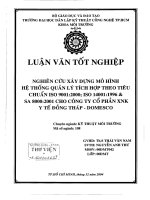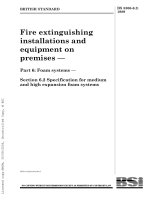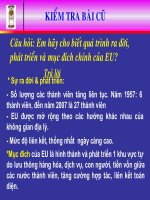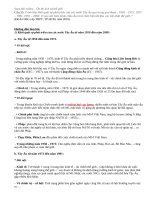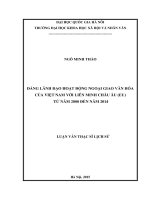Bsi bs au 265 2 1995 (2000) iso 6518 2 1995
Bạn đang xem bản rút gọn của tài liệu. Xem và tải ngay bản đầy đủ của tài liệu tại đây (685.25 KB, 16 trang )
Li cen sed Copy: Lon d on Sou th Ban k U n i versi ty, Lon d on Sou th Ban k U n i versi ty, Sat Dec 09 02: 08: 57 G M T+00: 00 2006, U n con trol l ed Copy, (c) BSI
BRITISH STANDARD AUTOMOBILE SERIES
BS AU
265 -2:1 995
ISO 65 1 8-2:
1 995
Incorp orating
Am endm ent No.
Road vehicles —
Ignition systems —
Part 2: Electrical performance and
function test methods
IC S 43 . 0 60 . 5 0
1
Li cen sed Copy: Lon d on Sou th Ban k U n i versi ty, Lon d on Sou th Ban k U n i versi ty, Sat Dec 09 02: 08: 57 G M T+00: 00 2006, U n con trol l ed Copy, (c) BSI
BS AU 265 -2:1 995
Committees responsible for this
British Standard
The p rep aration of this Britis h S tandard was entrus ted to Technical
C ommittee MC E /9, Ignition equip ment for sp ark ignition engines , up on which
the following b odies were rep res ented:
S ociety of Motor Manufacturers and Traders Ltd.
C oop ted memb ers
This Britis h S tandard, having
b een p rep ared under the
direction of the E ngineering
S ector Board, was p ub lis hed
under the authority of the
S tandards Board and comes
Amendments issued since publication
into effect on
1 5 D ecemb er 1 9 9 5
© BS I 0 3 - 2 0 0 0
Amd. No.
D ate
C omments
961 0
S ep temb er
Indicated b y a s ideline in the margin
1 99 7
The following BS I references
relate to the work on this
s tandard:
C om mittee reference MC E /9
D raft for comment 9 3 /70 92 45 D C
ISBN 0 5 80 24945 X
Li cen sed Copy: Lon d on Sou th Ban k U n i versi ty, Lon d on Sou th Ban k U n i versi ty, Sat Dec 09 02: 08: 57 G M T+00: 00 2006, U n con trol l ed Copy, (c) BSI
BS AU 265 -2:1 995
Contents
Page
Committees responsib le
Inside front cover
National foreword
ii
1
Scope
1
2
Ignition system description
1
1
3
Test equipment
4
Parameters to be measured or determined
5
5
Procedures
7
Figure 1 — Test circuit for ignition systems with mechanical
distributor
2
Figure 2 — Test circuit for static ignition systems with
single- ended coils
3
Figure 3 — Test circuit for static ignition systems with
doub le- ended coils
4
Figure 4 — Examples of measurements performed on ignition
systems
6
Figure 5 — Setting of pointed spark gap
8
Figure 6 — Spark gap electrode requirements
9
Tab le 1 — Test conditions
7
List of references
© BSI 03- 2 000
Inside back cover
i
Li cen sed Copy: Lon d on Sou th Ban k U n i versi ty, Lon d on Sou th Ban k U n i versi ty, Sat Dec 09 02: 08: 57 G M T+00: 00 2006, U n con trol l ed Copy, (c) BSI
BS AU 265 -2:1 995
National foreword
This British Standard has been prepared by Technical Committee MCE/9. It is
Road vehicles — Ignition systems —
Part 2: Electrical performance and function test methods , including Technical
identical with ISO 651 8- 2: 1 995
Corrigendum 1 , published by the International Organization for Standardization
(ISO) .
A British Standard does not purport to include all the necessary provisions of a
contract. Users of British Standards are responsible for their correct application.
Compliance with a British Standard does not of itself confer immunity
from legal obligations.
Summary of pages
This document comprises a front cover, an inside front cover, pages i and ii,
pages 1 to 1 0, an inside back cover and a back cover.
This standard has been updated (see copyright date) and may have had
amendments incorporated. This will be indicated in the amendment table on the
inside front cover.
ii
© BSI 03- 2000
Li cen sed Copy: Lon d on Sou th Ban k U n i versi ty, Lon d on Sou th Ban k U n i versi ty, Sat Dec 09 02: 08: 57 G M T+00: 00 2006, U n con trol l ed Copy, (c) BSI
ISO 651 8-2:1 995(E)
1 Scope
This part of ISO 6518 specifies the methods and test
conditions for testing battery-supplied ignition
systems for spark-ignited internal combustion
engines.
Because of the difficulties in producing repeatable
measurements with atmospheric spark gaps and
different observers, two methods of obtaining the
results necessary for calculating the system output
energy are given.
Method A — using spark gaps for the energy
measurement (test arrangement A).
The output energy obtained by this method is called
spark energy, Esp.
Method B — using a Zener diode string for the
energy measurement (test arrangement B).
The output energy obtained by this method is called
Zener discharge energy, Ezd.
This method is not suitable for systems giving
alternating spark current.
Method B is also recommended for the comparative
testing of ignition coils and current interruption
systems.
2.2 Static (distributorless) ignition system
with single-ended coils
The following components shall be interconnected
as shown in Figure 2 or in any other circuit which
has been proved to be equivalent.
2.2.1 Coils which, depending on the system tested,
may be
— single-ended coils as described in 2.1 .1 , or
— a multiple high-tension terminal assembly
formed by single-ended coils, or
— plug-top coils.
2.2.2 Auxiliary switching device implicit with
the system being tested such as a transistorized
control unit.
2.3 Static (distributorless) ignition system
with double-ended coil(s)
The following components shall be interconnected
as shown in Figure 3 or in any other circuit which
has been proved to be equivalent.
2.3.1 Coils which, depending on the system tested,
may be
— double-ended coils, or
— a multiple high-tension terminal assembly
formed
by double-ended coils.
2 Ignition system description
Auxiliary switching device implicit with
For the tests described in the following subclauses, 2.3.2
the
system
being tested such as a transistorized
the ignition system components used shall be as
control
unit.
specified for the application being examined, i.e. to
the original equipment specification.
3 Test equipment
2.1 Ignition system with mechanical
3.1 Variable d.c. power supply having a 10 %
distributor
to 90 % transient recovery time of not more
The following components shall be interconnected than 50 4s over the load range encountered in use.
as shown in Figure 1 or in any other circuit which It shall have no more than 50 mV variation in
has been proved to be equivalent.
average voltage from no-load to full ignition system
2.1 .1 Single-ended coil which can be the
load and no more than 100 mV peak-to-peak ripple
conventional induction coil or an air or magnetic
over the same load range. This power supply may be
core transformer.
substituted by a battery with or without a charging
system. The power supply shall be positioned
2.1 .2 Coil ballast resistor or resistors, if the coil
immediately
adjacent to the system being tested.
being tested requires a ballast resistor, or any fixed
or variable means to make the voltage and/or the 3.2 Oscilloscope with a maximum rise time
current in the ignition circuit vary.
of 35 ns, with a minimum band pass of 10 MHz,
shall be used (P1 and P2). The overall uncertainty of
2.1 .3 Distributor which distributes the ignition
measurement including voltage and current probes
impulses to the spark-plugs. It may also contain
(see
3.3 and 3.4 ) shall be less than 3 %.
means of triggering and/or timing adjustment, all of
which have a proper angular interrelationship to
3.3 Voltage probe (RD ) with an input capacitance
themselves and to the engine.
smaller than or equal to 5 pF and an input
resistance of 100 M7 or greater.
2.1 .4 Auxiliary switching device implicit with
the system being tested such as a transistorized
3.4 Current probe (P 1 ) suitable for d.c. to 10 MHz.
control unit.
3.5 d.c. ammeter (P3 ) with a maximum voltage
drop of 100 mV under test conditions.
© BSI 03-2000
1
Li cen sed Copy: Lon d on Sou th Ban k U n i versi ty, Lon d on Sou th Ban k U n i versi ty, Sat Dec 09 02: 08: 57 G M T+00: 00 2006, U n con trol l ed Copy, (c) BSI
ISO 651 8-2:1 995(E)
1)
The distance between rotor electrode and cap electrode shall be maintained
constant during spark duration or as agreed between user and supplier.
2)
The arrow shows the sequence of the sparks.
3)
Set according to 5.3.1 .
Key
P1
= current probe, amplifier and oscilloscope
C1
= load capacity
P2
= voltage- measuring oscilloscope
R1
= load resistor
P3
= d. c. ammeter
R 2 to R 1 0
P4
= d. c. voltmeter
P5
= tachometer
NOTE
= suppression impedances (the current and resistance of which
are fixed by agreement between the manufacturer and the user)
RD
= voltage probe
An example of an eight- cylinder system is shown
Figure 1 — Test circuit for ignition systems with mechanical distributor
2
© BSI 03- 2000
Li cen sed Copy: Lon d on Sou th Ban k U n i versi ty, Lon d on Sou th Ban k U n i versi ty, Sat Dec 09 02: 08: 57 G M T+00: 00 2006, U n con trol l ed Copy, (c) BSI
ISO 651 8-2:1 995(E)
1)
Set according to 5.3.1 .
Key
P1
= current probe, amplifier and oscilloscope
C1
= load capacity
P2
= voltage- measuring oscilloscope
R1
= load resistor
P3
= d. c. ammeter
R 2 to R9
P4
= d. c. voltmeter
P5
= tachometer (crankshaft rotational frequency
= suppression impedances (the current and resistance of which
are fixed by agreement between the manufacturer and the user)
RD
= voltage probe
signal)
NOTE
An example of an eight- cylinder system is shown
Figure 2 — Test circuit for static ignition systems with single-ended coils
© BSI 03- 2000
3
Li cen sed Copy: Lon d on Sou th Ban k U n i versi ty, Lon d on Sou th Ban k U n i versi ty, Sat Dec 09 02: 08: 57 G M T+00: 00 2006, U n con trol l ed Copy, (c) BSI
ISO 651 8-2:1 995(E)
1)
Set according to 5.3.1 .
Key
P1
= current probe, amplifier and oscilloscope
C1
= load capacity
P2
= voltage- measuring oscilloscope
R1
= load resistor
P3
= d. c. ammeter
R 2 to R 9
P4
= d. c. voltmeter
P5
= tachometer (crankshaft rotational frequency
= suppression impedances (the current and resistance of which
are fixed by agreement between the manufacturer and the user)
RD
= voltage probe
signal)
NOTE 1
For double- ended coils, secondary outlets shall be tested at high voltage.
NOTE 2
An example of an eight- cylinder system is shown.
Figure 3 — Test circuit for static ignition systems with double-ended coils
4
© BSI 03- 2000
Li cen sed Copy: Lon d on Sou th Ban k U n i versi ty, Lon d on Sou th Ban k U n i versi ty, Sat Dec 09 02: 08: 57 G M T+00: 00 2006, U n con trol l ed Copy, (c) BSI
ISO 651 8-2:1 995(E)
(P4) with an input resistance of at
least 10 k7/V and with sufficient resolution to
indicate differences of 10 mV easily.
3.7 Distributor or trigger wheel drive stand
and attached tachometer (P5) conforming to the
following:
a) a continuously variable rotational frequency
adjustment, capable of being varied
between 10 min–1 and 4 000 min–1 for a
distributor drive stand and between 20 min–1 and
at least 6 000 min–1 for a trigger wheel
drive stand;
b) the rotational frequency shall be within ± 5 %
below 400 min–1 and ± 20 min–1
above 400 min–1 ;
c) a tachometer accurate to within ± 0,2 % of
indicated rotational frequency.
3.8 Loads shall be connected to the ignition system
by high-voltage, non-resistive metal conductor
ignition cables. The length depends on the
capacitive load (see 3.8.2 ).
3.8.1 Multi-point spark gap stand , each gap
being individually variable (see Figure 5).
3.8.2 The capacitance C1 simulates the
capacitance of the cables and spark-plugs as
normally encountered on the engine. This
capacitance shall be a low dissipation factor (not
greater than 3 % at 1 kHz) secondary ignition cable
of a length such that, in conjunction with the
capacitor and high-tension probe, the total
capacitance is
50 pF to 55 pF for ignition systems with
distributor;
25 pF to 30 pF for static ignition system with
single-ended coils;
50 pF to 55 pF for static ignition systems with
double-ended coils.
To measure the total capacitance, the distributor
spark gaps, and the impedances R2 to R10 if lumped
resistors, shall be shunted and the ignition cable
shall be removed from the ignition coil.
3.6 Voltmeter
NOTE 1 It may be necessary to consider the effect of parasitic
capacitances.
NOTE 2 Other values of capacitance may be agreed upon
depending on the application.
The resistor R1 simulates lead or carbon
fouled spark-plugs. This resistor shall have a low
voltage coefficient (maximum 0,000 5 %/V),
non-inductive, approximately 10 W
and 1 M7 ± 5 %. It shall be connected in parallel to
the capacitance for some measurements.
3.8.3
3.8.4 A Zener diode string of 1 kV for single-ended
coils and two Zener diode strings of 1 kV
and 0,5 kV for double-ended coils (see Figure 3),
each with a Zener voltage tolerance of ± 5 % under
test conditions.
4 Parameters to be measured or
determined
4.1 Available voltage, Uav
Comparing the available voltage, Uav, to the voltage
required, Uspc, to fire spark-plugs in a given engine
determine the adequacy of the ignition system
[see Figure 4 a)]. It shall be measured when the
system is loaded with the capacitance C1 described
in 3.8.2 .
4.2 Minimum available voltage, Uavm
The minimum available voltage1) , Uavm, shall be
measured when the system is loaded with the
capacitance C1 and the resistor R1 connected in
parallel. The minimum amplitude shall be recorded.
This represents the level which can be guaranteed
from the system being tested at an ambient
temperature of 23 °C ± 5 °C, a trigger wheel
rotational frequency of 2 000 min–1 and a supply
voltage of 13,5 V.
4.3 Secondary output voltage, Us
The secondary output voltage, Us, may also be
measured for comparison with values obtained for
available voltage, Uav.
4.4 Interruption current, Ipi
The interruption current1) , Ipi, determines the
energy into the system [see Figure 4 c)].
4.5 Average current input, Ipar
The average current input, Ipar, determines the
average current draw of the system with respect to
the d.c. source (alternator, generator, battery, etc.).
4.6 Energy
4.6.1
In du c tiv e sp a rk en ergy,
Espi
The inductive spark energy2) , Espi, is determined by
test method A (see 5.3.1 ). It is calculated from the
integration of the product of the measured values of
spark voltage, Usp [adjusted to Ue: see Figure 4 f)]
and spark current Isp over the spark duration tfsp
[see Figure 4 f)].
1) This measurement does not apply to capacitor discharge ignition systems.
2) This is an indication of the amount of electrically caused erosion which will occur on spark-plug electrodes. Experience is
required to use this information effectively.
© BSI 03-2000
5
Li cen sed Copy: Lon d on Sou th Ban k U n i versi ty, Lon d on Sou th Ban k U n i versi ty, Sat Dec 09 02: 08: 57 G M T+00: 00 2006, U n con trol l ed Copy, (c) BSI
ISO 651 8-2:1 995(E)
4.6.2
Zen er disc ha rge en ergy,
The Zener discharge energy,
E
zd,
E
4.6.4
zd
is determined by
Ma ximu m sp a rk c u rren t,
I
spm , or
m a xim u m Zen er disc h a rge c u rren t,
3)
I
test method B. It is calculated from the integration
The maximum spark current
Zener discharge current is the instantaneous
discharge voltage
zd
U
zd
and Zener discharge current
over the Zener discharge duration
t
fzd
[see Figure 4 g)] .
spm ,
zdm
of the measured values of the product of Zener
I
,
I
current from the secondary winding of the ignition
coil flowing through the spark gap after breakdown
[see Figure 4 f)] or through the Zener diodes
[see Figure 4 g) ] .
4.6.3
Sp a rk du ra ti on o r Zen er disc h a rge
4.7 Secondary voltage rise time,
t
The secondary voltage rise time,
is an indication
t
sUr ,
sUr
of the ability of an ignition system to fire shunted
(fouled) spark- plugs. The shorter the secondary
du ra ti o n
This duration within limits is indicative of the
igniting capability of the ignition coil output under
marginal fuel conditions
2)
[see Figure 4 d),
Figure 4 f) and Figure 4 g)] .
voltage rise time, the less system energy is lost
across the fouled shunt and more voltage is
available to fire the spark- plug [see Figure 4 b)] .
It shall be measured when the system is loaded with
the capacitance
resistor
1)
or maximum
R
1
C
1
described in 3.8.2 and the
described in 3.8.3 .
The wave form shown occurs in ingnition systems with contact breaker.
Figure 4 — Examples of measurements performed on ignition systems
3)
6
This measurement does not apply to capacitor discharge ignition systems.
© BSI 03- 2000
Li cen sed Copy: Lon d on Sou th Ban k U n i versi ty, Lon d on Sou th Ban k U n i versi ty, Sat Dec 09 02: 08: 57 G M T+00: 00 2006, U n con trol l ed Copy, (c) BSI
ISO 651 8-2:1 995(E)
U
n
To facilitate comparison between systems, the
supply
secondary voltage rise time shall be determined
crankshaft
between – 1 , 5 kV and – 1 5 kV, to be repeated
between + 1 , 5 kV and + 1 5 kV for double- ended coils
The coil primary induced voltage
4)
,
U
= 2 000 min –1 .
5 Procedures
or as agreed between user and manufacturer.
4.8 Coil primary induced voltage,
= 1 3, 5 V;
U
5.1 General
pind
pind ,
The circuit arrangements shown in Figure 1
is useful
to Figure 3 with instrumentation in place can be
with respect to contact breaker life in classic
used to measure the parameters in clause 4 .
ignition systems and is an indication of the stress on
Test arrangement A is intended for tests to confirm
a semiconductor power switch (unless voltage
clamping is used) in inductive energy storage
the required system functions and system
ignition systems [see Figure 4 e)] . If it shall be
performance.
measured, it may be necessary to use a measuring
Test arrangement B is intended for tests to compare
instrument with a differential input.
the performance of ignition coils and current
The primary induced voltage wave form is always
interruption systems.
preceded (usually within 20
5.2 Test conditions
4s) by a leakage
induction spike. Usually this is ignored in
The test conditions shall be chosen from Table 1 as
calculations but if the area under the spike curve
appropriate.
becomes significant then it is essential that it be
During simulated starting tests, the system shall be
taken into account, when considering the effect on
operated under conditions simulating vehicle
solid state components.
4.9 Ignition-limiting load resistance,
R
electrical conditions for the primary side of the
1 5 kV
system. For example, if a resistor in series with the
The shunt behaviour of an ignition system is also
primary coil is normally shunted during engine
determined by its ignition- limiting load resistance,
cranking, this resistor shall be shunted for this
R
1 5 kV.
It is the load resistance at which the absolute
value of the available voltage,
U
The designation for it is
(see R 1 in Figure 1
R
1 5 kV
av,
portion of bench tests.
falls to 1 5 kV.
5.2.1
The supply voltages,
to Figure 3).
C
1
U
U
sup
sup ,
given in Table 1 , are
based on 1 2 V nominal voltage. If 24 V systems are
The parameters are
C load (see
Su p p ly v olta ge,
to be tested, multiply these voltages by two.
in Figure 1 to Figure 3) as described
in 3.8.2 .
Table 1 — Test conditions
Trigger wheel
rotational
frequency
Ambient temperature
Supply voltage
U
a
°C
Test at operational temperature
sup
± 0, 1
Test at room
min–1
Ib
V
condition
Temperature class
temperature
II c
Operating
III c
40
6
+ 23 ± 5
– 30 ± 3
1 00
10
+ 23 ± 5
+ 80 ± 2
+ 1 00 ± 2
+ 1 20 ± 2
Warm starting
1 3, 5
+ 23 ± 5
+ 80 ± 2
+ 1 00 ± 2
+ 1 20 ± 2
Running
Cold starting
500
1 000
2 000
3 000
4 000
5 000
6 000
7 000
8 000
a
b
c
4)
For the distributor rotational frequency, divide by two.
Class I is preferred for items mounted in vehicle cabin or similar environment.
Class II or III is preferred for items mounted on or near the engine.
This measurement does not apply to capacitor discharge ignition systems.
© BSI 03- 2000
7
Li cen sed Copy: Lon d on Sou th Ban k U n i versi ty, Lon d on Sou th Ban k U n i versi ty, Sat Dec 09 02: 08: 57 G M T+00: 00 2006, U n con trol l ed Copy, (c) BSI
ISO 651 8-2:1 995(E)
The oscilloscope P2 (see 3.2 ) and the voltage probe
RD (see 3.3 ) shall be used to measure the spark
Allow the ignition system to soak at least 1 h at the voltage
and the spark duration. The voltage probe
temperatures listed in Table 1 before beginning
shall
be
connected to a spark gap that has been
tests.
adjusted
a value Usp. To measure the spark
Before any readings are recorded at any of the test current, atocurrent
probe shall be used as shown
points, the system shall be allowed to come to a
in
Figure
1
to
Figure
3, test arrangement A.
thermally stable operating condition to be agreed
5.3.2 Test method B — Zener discharge energy
upon between manufacturer and user.
When environmental equipment is used to control Test method B shall be used with test
ambient temperature, care shall be taken that wire arrangement B to compare the performance and
and/or cable lengths and, consequently, impedances function of ignition coils and current interruption
systems.
do not distort test results.
For the energy measurement, a Zener diode string
5.3 Test methods
of 1 kV as shown in Figure 1 and Figure 2, test
Test methods A and B differ in the test arrangement arrangement
or one Zener diode string of 1 kV
for the energy measurement (spark voltage or Zener and one ZenerB,diode
string of 0,5 kV as shown
discharge voltage, spark current or Zener discharge in Figure 3 shall be used.
The discharge current
current, and spark duration or Zener discharge
used
for
the
energy
calculation
shall be measured by
duration)
using a current probe as shown in Figure 1
The resulting energies calculated will differ.
to Figure 3, test arrangement B.
5.3.1 Test method A — Inductive spark energy
The energy calculation is given in 4.6.2 .
Test method A is closest to a vehicle installation and The oscilloscope P2 and the voltage probe RD are
shall be used with test arrangement A to confirm used as shown in Figure 1 to Figure 3 to measure
the system functions. It shall be used to measure the the voltage across the Zener diode string and the
parameters in clause 4 under the conditions given discharge duration.
in 5.2 and the appropriate condition in Table 1.
The calculation in 4.6.1 with this procedure
determines the inductive part of the spark energy
discharged in a spark gap as shown in Figure 5
and Figure 6. The spark gap for single-ended coils
shall be set to give a spark voltage Usp of 1 kV ± 5 %.
For double-ended coils (see Figure 3), two spark
gaps shall be used, one set to 1 kV ± 5 %, the other
to 0,5 kV ± 5 % for each secondary winding.
5.2.2
Ambient temperatures
Figure 5 — Setting of pointed spark gap
8
© BSI 03-2000
Li cen sed Copy: Lon d on Sou th Ban k U n i versi ty, Lon d on Sou th Ban k U n i versi ty, Sat Dec 09 02: 08: 57 G M T+00: 00 2006, U n con trol l ed Copy, (c) BSI
© BSI 03- 2 000
Figure 6 — Spark gap electrode requirements
ISO 651 8-2:1 995(E)
9
Li cen sed Copy: Lon d on Sou th Ban k U n i versi ty, Lon d on Sou th Ban k U n i versi ty, Sat Dec 09 02: 08: 57 G M T+00: 00 2006, U n con trol l ed Copy, (c) BSI
10
blank
Li cen sed Copy: Lon d on Sou th Ban k U n i versi ty, Lon d on Sou th Ban k U n i versi ty, Sat Dec 09 02: 08: 57 G M T+00: 00 2006, U n con trol l ed Copy, (c) BSI
List of references
See national foreword.
© BSI 03- 2 000
BS AU 265 -2:1 995
Li cen sed Copy: Lon d on Sou th Ban k U n i versi ty, Lon d on Sou th Ban k U n i versi ty, Sat Dec 09 02: 08: 57 G M T+00: 00 2006, U n con trol l ed Copy, (c) BSI
BS AU
265 -2:1 995
ISO 65 1 8-2:
BSI — British Standards Institution
1 995
BS I is the indep endent national b ody res p ons ib le for p rep aring
Britis h S tandards . It p res ents the UK view on s tandards in E urop e and at the
international level. It is incorp orated b y Royal C harter.
Revisions
Britis h S tandards are up dated b y amendment or revis ion. Us ers of
Britis h S tandards should make s ure that they p oss es s the latest amendments or
editions .
It is the constant aim of BS I to imp rove the quality of our p roducts and services .
We would b e grateful if anyone finding an inaccuracy or amb iguity while us ing
this Britis h S tandard would inform the S ecretary of the technical committee
res p ons ib le, the identity of which can b e found on the inside front cover.
Tel: 02 0 89 96 90 00. Fax: 02 0 89 96 7 40 0 .
BS I offers memb ers an individual up dating s ervice called PLUS which ens ures
that s ub s crib ers automatically receive the lates t editions of s tandards .
Buying standards
O rders for all BS I, international and foreign s tandards p ub lications s hould b e
addres s ed to C us tomer S ervices. Tel: 0 2 0 899 6 9 00 1 . Fax: 0 2 0 899 6 7001 .
In res p ons e to orders for international standards , it is BS I p olicy to sup p ly the
BS I imp lementation of thos e that have b een p ub lis hed as Britis h S tandards,
unless otherwis e requested.
Information on standards
BS I p rovides a wide range of information on national, E urop ean and
international standards through its Lib rary and its Technical H elp to E xp orters
S ervice. Various BS I electronic information s ervices are also availab le which give
details on all its p roducts and s ervices . C ontact the Information C entre.
Tel: 02 0 89 96 71 1 1 . Fax: 02 0 89 96 7 048.
S ub s crib ing memb ers of BS I are kep t up to date with s tandards develop ments
and receive sub s tantial discounts on the p urchase p rice of s tandards. For details
of thes e and other b enefits contact Memb ership Adminis tration.
Tel: 02 0 89 96 70 02 . Fax: 02 0 89 96 7 00 1 .
Copyright
C op yright s ub s is ts in all BS I p ub lications . BS I als o holds the cop yright, in the
UK, of the p ub lications of the international s tandardization b odies . E xcep t as
p ermitted under the C op yright, D es igns and Patents Act 1 988 no extract may b e
rep roduced, s tored in a retrieval s ystem or transmitted in any form or b y any
means – electronic, p hotocop ying, recording or otherwis e – without p rior written
p ermis s ion from BS I.
This does not p reclude the free us e, in the cours e of imp lementing the standard,
of necess ary details such as s ymb ols, and size, typ e or grade designations. If thes e
details are to b e used for any other p urp os e than imp lementation then the p rior
written p ermiss ion of BS I must b e ob tained.
If p ermis sion is granted, the terms may include royalty p ayments or a licensing
agreement. D etails and advice can b e ob tained from the C op yright Manager.
BS I
3 89 C his wick H igh Road
London
W4 4AL
Tel: 02 0 89 96 70 7 0.

